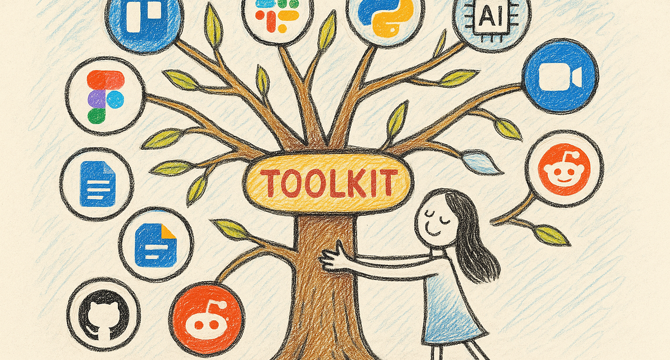Product Management News
Medium
259

AI Ethics in Product Management: Balancing Innovation with Responsibility
- Product Managers play a crucial role in shaping human experiences and ensuring ethical practices when implementing AI systems.
- It is essential for Product Managers to prioritize ethical AI practices, such as keeping critical decisions reviewable by humans, informing users when interacting with AI, and ensuring transparency and control over data usage.
- Ethical lapses in AI systems can lead to significant reputational damage and must be avoided through responsible product management.
- Instances of bias in AI models highlight the importance of ethical oversight by Product Managers to prevent such failures and maintain trustworthy AI products.
Read Full Article
15 Likes
Medium
437

Image Credit: Medium
When Your Product Talks Back
- The future of Opinionated AI envisions products that interact with users in a more personalized and expressive manner, exhibiting thought, feelings, and opinions.
- Examples include a meeting tool adding remarks to notes, a planning tool reminding about uncompleted tasks, and a design tool providing feedback on user demographics.
- The integration of AI in various product stages leads to tools that understand context, interpret sentiment, deliver critique, and guide decisions, emphasizing the importance of designing personalities for products.
- The evolving role of AI in products requires empathy, humor, and appropriate boundaries to ensure user interaction is supportive and engaging, transforming products into genuine teammates.
Read Full Article
26 Likes
Medium
418

Image Credit: Medium
The product work behind the product work
- Doing good product work in a place that doesn’t recognize it can be challenging.
- The article highlights the unseen efforts involved in product development.
- It discusses the struggle of pushing for quality in organizations focused on output.
- Product work may involve untangling myths, pushing back against culture, and prioritizing real problems.
- The narrative emphasizes the importance of creating a product culture before building a product.
- Effective product leadership involves shaping conditions for better decisions over time.
- Quiet leadership involves subtle efforts like asking critical questions and shifting habits towards better outcomes.
- The article touches upon the emotional and cognitive labor that often goes unrecognized in product work.
- Acknowledgement and support for individuals doing unseen but crucial work are crucial to prevent burnout and maintain team cohesion.
- The value of recognizing and appreciating the 'quiet glue' that holds teams together is highlighted.
Read Full Article
25 Likes
Medium
323

Image Credit: Medium
Cultivating the AI-Native Mindset: Building Literacy Through Doing and Discovery
- The AI-Native mindset involves engaging AI as a creative partner within human+AI teams, focusing on building literacy through exploration, dialogue, and bold experimentation.
- Cultivating this mindset requires creating an environment that encourages learning by doing, embracing the unexpected, and operating responsibly while aligning with organizational strategy.
- The article shares the author's experience in creating a movie, CTRL+ALT+EVOLVE, with the help of AI, emphasizing the importance of trial and error, critical thinking, and resilience in the learning process.
- Feedback from early screenings pushed the author to improve storytelling techniques, leading to a journey of self-realization and expanded creative capabilities.
- The author also explores the Multiverse Machine project, showcasing how AI can aid in understanding and critiquing images, highlighting the importance of leveraging AI tools to lower barriers to entry in creative endeavors.
- The article emphasizes developing the AI-native mindset for work through structured approaches like Assess-Experiment-Scale, focusing on responsible, creative experimentation and scaling successful practices across the organization.
- It discusses the need for coaching and expert engagement, whether from human, AI-powered, or mixed teams, to bridge experimentation with a nuanced understanding of seasoned professionals, fostering a human-centric creative ecosystem.
- Embracing a hands-on approach to learning and enabling creative intelligence across the organization is crucial in the AI era, where formal training may lag behind, requiring a democratized approach to learning with support from guardrails.
- Developing an AI-native mindset and honing creative intelligence is deemed essential for navigating the evolving landscape and fostering human+AI collaboration effectively by continuously adapting and redefining possibilities.
- The article concludes that the future of work lies in human+AI collaboration, driven by an AI-native mindset and creative intelligence, facilitating continuous learning and responsible innovation.
- The article is part of a series focusing on how AI redefines creativity, design, and leadership, drawing insights from projects such as the Multiverse Machine, CTRL+ALT+EVOLVE movie, and Agentic AI research for a human+AI designed future.
Read Full Article
19 Likes
Discover more
- Programming News
- Software News
- Web Design
- Devops News
- Open Source News
- Databases
- Cloud News
- Operating Systems News
- Agile Methodology News
- Computer Engineering
- Startup News
- Cryptocurrency News
- Technology News
- Blockchain News
- Data Science News
- AR News
- Apple News
- Cyber Security News
- Leadership News
- Gaming News
- Automobiles News
Medium
356

Image Credit: Medium
Beyond Segmentation: How AI-Driven Hyper-Personalization (Fueled by Analytics) is Redefining…
- Artificial Intelligence (AI) plays a crucial role in hyper-personalization, processing vast datasets to understand individual preferences and predict intent accurately.
- AI aids in content generation, variation, orchestration, and delivery of personalized experiences, leading to significant revenue generation for companies excelling in personalization.
- Analytics complements AI in executing hyper-personalization effectively by providing continuous feedback loops for intelligent and adaptive personalization strategies.
- Product Managers can leverage AI for scale, analytics for insights, and a strategic fusion of the two to move towards true 1:1 hyper-personalization, driving customer engagement and business growth.
Read Full Article
21 Likes
Medium
54

Image Credit: Medium
My Product Mindset Toolkit
- Product management is a mindset that involves navigating ambiguity, fostering collaboration, and driving progress.
- Tools like Trello, Miro, Figma, Canva, and Google Sheets aid in shaping roadmaps, brainstorming, creating mockups, and analyzing data.
- Platforms like Reddit, GitHub, Google Docs, and Slack are used to track trends, explore open-source projects, collaborate, and communicate.
- AI tools such as ChatGPT, Perplexity, and platforms like Semantic Scholar enhance workflow efficiency for product managers.
Read Full Article
3 Likes
Medium
100

Image Credit: Medium
Why I Still Practice UX as a Product Manager
- Started as a UX designer and continues to practice UX principles as a Product Manager.
- Believes that transitioning into product management was a natural progression from UX, combining user empathy with decision-making power.
- Emphasizes the importance of maintaining a close connection with users and leveraging UX instincts to enhance product management decisions.
- Shares a success story where a small UI clarification based on UX insights led to a significant improvement in user experience post-launch.
Read Full Article
6 Likes
Medium
396

Image Credit: Medium
Streamline Creativity with Apparel PDM Software by A2000
- A2000's Design/PDM Module offers a digital atelier experience, supporting every step from sketching to production-ready tech packs.
- A2000's apparel software integrates seamlessly with various systems, eliminating the need for third-party patches and providers.
- Real-time data visibility is a standout feature of A2000, allowing quick access to all necessary information for faster decision-making.
- A2000's Apparel PDM Software streamlines design and production processes for growth, catering to designers, manufacturers, wholesalers, and retailers in the fashion industry.
Read Full Article
23 Likes
Medium
396

Image Credit: Medium
Prototyping Gen AI Applications: A Practical Guide to Doing It Right
- Generative AI (Gen AI) applications require a balanced approach between user needs, business objectives, and technical capabilities, with the need for rapid prototyping due to the unpredictable nature of outputs.
- Marty Cagan outlines four types of prototypes for Gen AI projects: Feasibility, User, Live-Data, and Hybrid Prototypes, crucial for testing integrations, usability, and real data.
- Differentiating between proof of concept (POC) and prototypes, prototypes focus on user functionality while POC validates technical feasibility.
- The DVF framework by IDEO organizes prototypes around Desirability, Viability, and Feasibility, critical for focusing limited resources on key unknowns.
- Enterprise contexts introduce additional considerations like data governance, security, and compliance, which should be incorporated early into prototyping efforts.
- Viability prototyping assesses sustainability and alignment with business objectives, while feasibility prototyping validates technical capabilities and infrastructure readiness.
- Five key principles for effective Gen AI prototyping include starting simple, adding complexity incrementally, testing edge cases early, matching prototype fidelity to objectives, and planning for continuous iteration.
- Prototyping is an iterative process essential for maintaining alignment with evolving user requirements and technical constraints in successful Gen AI application development.
Read Full Article
23 Likes
Medium
122

Image Credit: Medium
Think Like a Product, Build Like a Pro: How Feedback Loops Make You a Smarter Developer
- Product thinking emphasizes building with feedback, not assumptions.
- Developers benefit by understanding the 'why' behind the 'what' to write purposeful code and avoid wasting time.
- Ship fast, invite early feedback, and incorporate tools like feature flags and beta channels for quicker validation.
- Integrate feedback loops into the deployment pipeline and close the loop publicly to show users they are heard.
Read Full Article
7 Likes
Medium
332

Image Credit: Medium
How to test a product viability hypothesis in 7 Days
- Rapid validation of product viability hypotheses can save time and resources while increasing chances of success.
- A systematic approach called SPRINT involves five stages: Starting with a clear, measurable hypothesis is crucial.
- Proper hypotheses address key questions and focus on specific target audiences and their willingness to pay.
- Testing demand by attempting to sell non-existent products can provide valuable insights before development.
- Engaging with real potential users through interviews often uncovers important feedback and adjustments to hypotheses.
- It's essential to be open to pivoting early based on validation results and user feedback.
- Tracking metrics like conversion rates and user engagement is vital to validate hypotheses effectively.
- Utilizing a fixed, short validation period of around seven days can drive focus and timely decision-making.
- Tools like landing page creators and interview platforms aid in quick validation but require proper methodology to be effective.
- Accepting negative results from rapid validation is important, as it can save significant time, resources, and prevent potential product failures.
Read Full Article
20 Likes
Medium
22

Image Credit: Medium
Product Development: Discovery, PoC, Prototype, and Beyond
- Discovery phase is crucial for understanding the problem, users, and opportunity before proceeding to build a product.
- Proof of Concept (PoC) determines technical feasibility and provides a go/no-go decision for further development.
- Prototypes help visualize and test user interface and experience, leading to validated design directions and refinement.
- Different stages like Minimum Demoable Product (MDP), MVP, Pilot, and Trial play vital roles in the product development journey, each focusing on specific aspects of validation and refinement.
Read Full Article
1 Like
Medium
164

How Duolingo Built a Global Education Powerhouse – Lessons for Business Leaders
- Duolingo maintains excellence as the default standard by hiring exceptional talent and rejecting the 'minimum viable product' mindset.
- The company emphasizes moving fast but letting data lead decision-making, ensuring speed with rigor in scaling what actually works.
- Engagement through delight is key for Duolingo, with playful branding and gamification boosting retention and passion in teams.
- Duolingo's blend of mission, rigor, and whimsy offers a blueprint for sustainable growth, aligning decisions with long-term vision and user trust.
Read Full Article
9 Likes
Scrum-Master-Toolbox
218

BONUS: Martti Kuldma shares how to transform century-old organizations through product-driven agile transformation
- Martti Kuldma, CEO of Omniva, discusses the agile transformation of the century-old company.
- Omniva transitioned from traditional postal services to modern logistics through product-driven agile practices.
- The company shifted focus to software as a revenue center, investing in innovative logistics solutions.
- Martti's strategic vision involves treating physical mailing as the next IP network for adaptable delivery.
- The transformation involved breaking down waterfall processes, moving towards agile product teams.
- Omniva created cross-functional product teams, empowering them with accountability for business outcomes.
- Martti emphasized the evolution of product managers to be directly accountable for business results.
- Leadership in transformation required storytelling skills for effective communication and alignment.
- Real-time feedback philosophy was endorsed for immediate and impactful professional development.
- Key transformation practices included compelling narratives, distributed decision-making, and business accountability for engineers.
Read Full Article
13 Likes
Medium
332

The Product Manager Who Talks to AI, Not Just About It
- This course is designed for product managers who want to enhance their AI fluency and ask strategic questions related to AI models and biases.
- It aims to equip PMs with enough technical and business knowledge to drive outcomes rather than just nodding vaguely in AI meetings.
- Participants will learn how to integrate AI into product strategy, evaluate model performance, and build user trust around AI applications.
- The course includes practical exercises like writing prompts, designing data loops, and testing prototypes to help product managers understand AI implementation in real-world scenarios.
Read Full Article
20 Likes
For uninterrupted reading, download the app